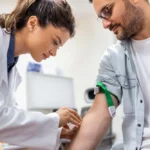“Am I rushing things if I have sex now?” I asked myself last autumn, fresh off a seven-day antifungal course—and by day five, the burning and itching had vanished. But a nagging concern remained: what if I go too soon and it returns? That’s what this article is for: to help you confidently know when it’s really safe to resume intimacy without risking relapse or irritation.
Why This Matters
Yeast infections (vaginal candidiasis) affect approximately 75% of people with vaginas at least once in their lifetime . Left unresolved, they can cause uncomfortable symptoms: burning, discharge, pain during intercourse and urination . Resuming sex too quickly can:
- Aggravate inflamed tissue
- Interrupt treatment effectiveness
- Risk partner transmission
- Increase likelihood of relapse
Wait Time by Treatment Type
| Treatment Method | Typical Duration | Recommended Wait Before Sex |
|---|---|---|
| Single-dose oral (fluconazole) | ~3 days to clear symptoms | Wait 3–7 days post-dose, once symptoms have fully cleared |
| Topical creams/suppositories (e.g., miconazole, clotrimazole) | 3–7 days | Wait until medication course is completed and symptoms gone, usually 7 days |
| Persistent or recurrent infections | Extended/multiple days of treatment | Consider waiting 10–14 days with full symptom resolution |
Crucial point: Scope beyond symptom resolution—tissue needs to regenerate and yeast levels must fully normalise.
Expert & Evidence Insights
- HealthTap doctors affirm: “Hold off on vaginal intercourse until your course of treatment is complete and you no longer have redness, itching or burning” .
- Medical News Today warns resuming sex early may prolong or worsen infection .
- Greatist recommends waiting around 7 days post-treatment, only after full symptom clearance .
- STDcheck.com advises abstaining throughout treatment until all symptoms vanish .
Real Talk: Anecdote & First-Hand Tips
Here’s how I put this into practice:
- Day 1–7: I used a miconazole vaginal cream each night.
- Days 3–5: Itching and discharge subsided—but I still felt slight soreness.
- Day 7: Cream course ended. No visible symptoms.
- Day 10: Gently resumed intimacy. No relapse.
Why wait those extra days? Mucosal lining takes longer to heal than symptoms take to disappear. Friction too soon could drag the healing process backwards.
Practical Steps Before You Resume
- Complete the full prescribed treatment, even if symptoms disappear early.
- Verify symptom clearance — no itching, burning, redness, unusual discharge.
- Let a few extra days pass—especially after topical treatments due to residual cream.
- Check condom compatibility: Oils in creams may weaken latex condoms .
- Consider testing or treating your partner—men can get balanitis; yeast can pass back and forth .
- Resume gently—use water-based lubricant; cotton underwear thereafter promotes healing .
Post-Healing Hygiene Habits
- Dry thoroughly after baths/shower
- Wear cotton, breathable underwear and loose clothing
- Avoid perfumed intimate washes or douches
- Support microbiome with low-sugar diet, possibly probiotic yoghurt (as tolerated)
- Complete partner treatment if involved to avoid ping-pong infections
FAQ Section
Q1: Can I resume oral sex?
Wait also until creams are fully absorbed. Lubrication can prolong residue; oral sex may still transmit yeast or irritate tissues .
Q2: What about anal sex?
Evidence is limited, but anal sex may introduce bacteria and upset vaginal flora. Best to wait the same duration as for vaginal sex.
Q3: Is yeast infection an STI?
No—but it can transfer during sex, particularly involving penile–vaginal or penile–anal contact. Approximately 15% of men may get symptoms .
Q4: What if I need repeat or longer treatment?
In recurrent cases (4+ infections/year), follow-up with a gynaecologist is advised. Healing buffers may stretch to 10–14 days.
Evergreen Takeaways
- Symptom-based readiness is key—don’t go by calendar alone.
- Treatment type matters—topical vs oral vs prolonged affects healing buffer.
- Partner health matters—support healing by preventing re-infection cycles.
- Latex condom integrity—topical oils can weaken them; switch to non-latex or skip until fully healed.
These principles will continue to apply, algorithm changes aside—because physiology doesn’t shift with SEO trends 😉
Expert Quote
Dr Heidi Fowler (HealthTap):
“Hold off on vaginal intercourse until your course of treatment is complete and you no longer have redness, itching or burning.”
Final Word: Ready, Set, Go—When You Really Are
- Symptom-free? Check.
- Treatment course completed? Check.
- Condom-safe? Swap if needed.
- Partner treated/tested? Ideal.
- Give it a couple of buffer days.
When you tick all that, you’re good to go—comfortably, and without risking relapse or transmission.
What’s Your Experience?
Did you follow a strict wait window, or did you bounce back sooner? Share your story below—it may help someone decide whether to wait a week… or two.




